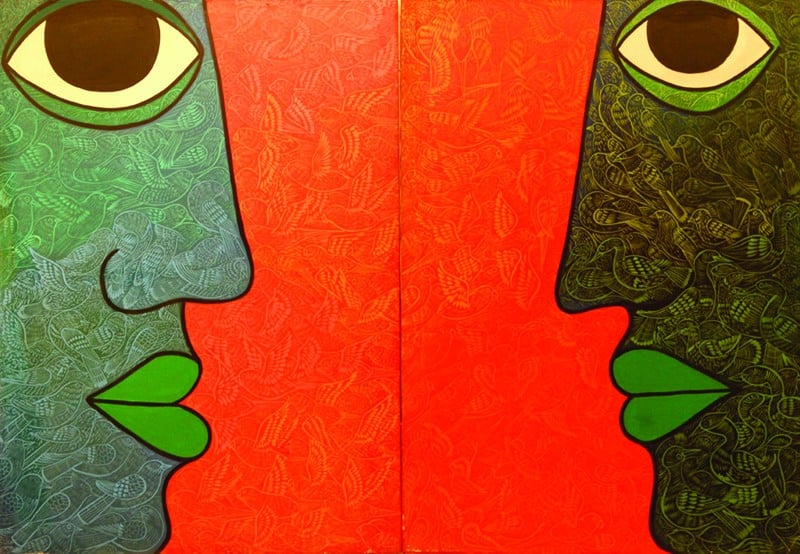
Faizaan Peerzada’s paintings and drawings in his Retrospective at Alhamra Art Gallery convince us of his place in the visual arts of this country

"All men contain several men inside them, and most of us bounce from one self to another without ever knowing who we are" -- Paul Auster
Though he used one name in his life, Faizaan Peerzada was a man of many faces. Known more for his work as a puppeteer as well as his contribution in promoting theatre, music and dance in our society, he was an eager and regular painter. He joined the National College of Arts in 1974, left the institution after one year, but continued to paint. A retrospective of his work opened on Dec 26, 2014 at the Alhamra Art Gallery, Lahore.
The show presents a fair amount of works from his life, comprising paintings, drawings and pastels. The viewer gets to know his evolution as a painter: his early canvases dripping with the influence of Ahmed Parvez (Peerzada was one among many artists who had the mark of Parvez on his art) to his later paintings depicting large scale faces, stylised in the scheme of an Indian mask or a puppet’s features. Along with painted surfaces, a substantial part of the exhibition consists of drawings -- of composite figures formed in the shape of upper half of human body and arms.
Inside these characters, with their outstretched hands, are numerous human beings, naked and in various postures, executed in singular black lines. A similar kind of imagery is visible in a few painted canvases, composed of faces or birds -- revealed only on closer contact. This type of image-making may appear simple or effortless but it is actually is a daunting task, because an artist is not only dealing with the larger image but is also tackling smaller units which complete a whole picture.
In comparison to these, other works show the artist’s impulsive usage of colour, his sense of design by making an image split into four identical sides/versions, and his fascination with portraits with big eyes. However, the composite works may relate to different aspects of Peerzada’s life in more than one way. On one level, these can be associated with his other passion: theatre and puppetry. An actor ceases to be a single human being and turns into a combination of various personas he has to play in front of spectators. In fact, he is usually praised on the basis of this blend, as people can not isolate the real from the acquired personality. In some cases the part played by an actor becomes so famous that it dominates the person’s identity.
In puppetry, too, the performer assumes the face and form of one or more puppet in his hands. So the audience experience a kind of assemblage: a sculpted figurine attached to strings with the voice of another person, who is reciting words or songs written mostly by someone else. Thus what moves in front of the curtain is not one but an outer layer of three or more personages.
In a way what Faizaan Peerzada portrayed was his observation of the world of altered appearances but, on another level, this body of work can be viewed as his self-portrait -- the split between the painter and the performer or the promoter of temporal arts. Not only Peerzada but many others face the dilemma of choosing between two loves. To pick an anomalous analogy, perhaps for Peerzada puppetry was the lawful wedlock responsibility whereas painting was like an infatuation with a mistress.
Yet one may also question the reason why Peerzada was more recognised as a performer than a painter. If one is not aware of his contribution in the realm of performing arts, his paintings and drawings are sufficient enough to convince his place in the visual arts of this country. For many, it comes as a surprise to see his art works since his other successes had eclipsed this side of his artistic personality.
This raises the issue of a person’s choice in terms of his creative expression. Should he be like a Renaissance man, excel in multiple disciplines and follow the examples of Leonardo da Vinci and Michelangelo, who worked as painters, sculptors, architects, poets and even scientists. This tradition was as much a part of Eastern cultures, too, where a philosopher could be a poet, medicine man, politician and calligrapher.
Ultimately, it depends on how faithful you are to one or more. Faizaan Peerzada seems equally devoted to both his passions. One hopes that the years to come will bring his other lost loves on surface and in public view.
(The exhibition will remain open till January 9, 2015)